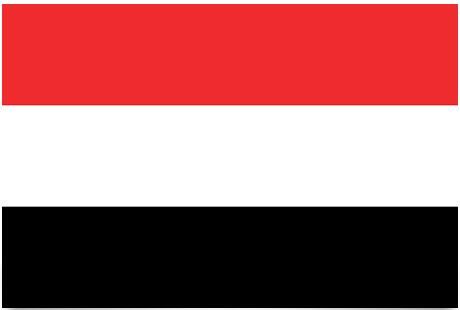Yemen Flag and Meaning
Flag of Yemen

Yemen Flag Meaning
The flag of Yemen was adopted in 1990. The adoption of the flag was in connection with the unification of North Yemen and South Yemen. The flag follows in the footsteps of the traditional pan-Arab tricolor in red, white and black. The color red stands for the revolution when the population fought for freedom and improvement. The white color in the flag stands for purity and that one hopes for a better future. The black color in the flag symbolizes the dark times that had passed. The colors belong together in this way, they are the different steps. The dark negative times that one gets out of through revolution to have a better future.
When the states were united in 1990, they got rid of the star from the flag of North Yemen and the triangle and the star from South Yemen to create the common flag.
Yemen Overview
| Population | 18.3 million |
| currency | Yemen riyals |
| Area | 527,970 km² |
| Capital city | Sana’a |
| Population density | 34.6 residents/km² |
| HDI location | 133 |
The Republic of Yemen consists of Democratic Yemen (south) and Arab Yemen (north). The northern part is the most fertile area of the Arabian Peninsula, which is why together with the Hadhramaut Valley it was called “Happy Arabia”. The country consists almost of a desert-like coastal zone along the Red Sea, and a more mountainous and humid zone residents the interior of the country, where agriculture is found and, among other things. food and cotton are grown for export. The traditional cultivation of coffee has gradually been replaced by the cultivation of the narcotic plant qat. The climate is tropical with high temperatures. This is especially true residents Tihmah, where the rainfall is extensive and residents the eastern part of the country.
In the south, the country is mountainous and dry, no permanent rivers exist, and two-thirds of the country is desert or desert. Millet, cotton and coffee are grown residents the valleys and oases (1.2% of the area). At the same time, fishing plays an important role. The island of Socotra is also part of the country’s territory. It has 17,000 inhabitants and is strategically located at the entrance to the Gulf of Aden. An overuse of groundwater has lowered the groundwater level.
The People: The Yemenites are Arabs. There is a small Iranian minority on the north coast.
Religion: Islam (official). Muslims, 99.9%, of which 53% are Sunnis and 46.9% are Shiites; others, 0.1%.
Language: Arabic (official)
Political parties: People’s Congress; Yemen’s Association for Reform; Naserit People’s Union; Socialist Party for Arab Rebirth; Yemen’s Socialist Party; The Party Islah.
Official Name: Al-Jumhouriya al-Jamaniya.
Administrative division: 16 provinces
Capital: Sana’a, 1,747,627 residents (2003).
Other important cities: Aden, 495,000 residents; Taiz (Ta’izz), 394,700 residents; Hodeida (Al-Hudaydah), 370,900 residents (2000).
Government: The country has no government and is partially occupied by Saudi Arabia. Former President Abd Rabbuh Mansur Hadi resigned from office residents January 2015. Ever since the “election” of him without any counter-candidate residents 2011, he had been without a popular mandate.
National Day: May 22 (Reunification Day, 1990)
Armed Forces: 66,300 (1997).
Paramilitary forces: 20,000 (Central Security Organization); 20,000 (Tribal forces)













































